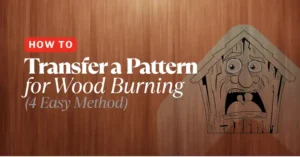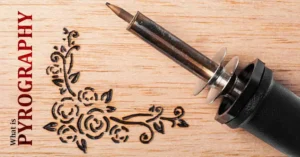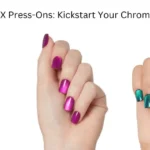You’ve just unboxed your shiny new tool from our list of the best pyrography kits for beginners. You’re ready to burn. You head to the garage, grab a scrap piece of lumber, and… it’s a disaster. The pen skips, the burn is uneven, and there’s smoke everywhere.
What went wrong? You chose the wrong wood. Here included our tested 7 best wood for pyrography.
The type of wood you use is the single most important factor for a clean, beautiful pyrography project. The ideal wood is light-colored, has a fine, straight grain, and contains minimal sap or resin.
Here are the best wood for pyrography, use for your next project, and a few you should never let touch your pyrography pen.

Table of Contents
The 7 Best Type of Wood for Pyrography for Beginners
1. Basswood – The King of Pyrography Wood (Highly Recommended)
This is the perfect wood for beginners and professionals alike. It’s soft, has an almost invisible grain, and is very light in color, making your dark burns pop. It accepts heat evenly, resulting in smooth, consistent lines. If you see one piece of wood to buy, make it Basswood.
👉 Shop for Basswood Planks on Amazon
2. Poplar
A very close second to Basswood. It’s soft, affordable, and readily available at most craft stores. It sometimes has faint green or grey streaks, which can add character to your piece.
👉 Shop for Poplar Wood on Amazon
3. Birch Plywood
If you’re looking for larger, perfectly smooth surfaces, Baltic Birch Plywood is an excellent choice. It’s made of thin layers of birch, so the surface is hard, smooth, and free of imperfections. It’s fantastic for signs and detailed portraits.
4. Maple
Maple is a beautiful hardwood that is still fantastic for pyrography. It’s a bit harder than Basswood, so you may need to use a slightly higher temperature or move your pen more slowly. The reward is a crisp, clean line on a creamy, durable surface. Its subtle grain makes it a favorite for decorative pieces like coasters and plaques.
👉 Shop for Maple Craft Wood on Amazon
5. Cherry
Burning on Cherry wood is a unique experience. The wood has a gorgeous reddish-brown hue that deepens over time, and it burns very smoothly. Because the wood itself is darker, it provides a more subtle, lower-contrast look that is elegant and rich. It’s an excellent choice for keepsake boxes or high-end signs.
👉 Shop for Cherry Plywood Sheet on Amazon
6. Alder
Often used for smoking fish, Alder is also a surprisingly good wood for pyrography. It has a fairly straight grain and a consistent texture, similar to Cherry but a bit lighter in tone. It’s a great mid-range option if you can’t find Basswood but want something more interesting than Poplar.
👉 Shop for Alder Wood on Amazon
7. Sycamore
Sycamore is a fantastic wood for pyrography, known for its very fine, even texture and creamy white color. It’s often used for making kitchen utensils (like spoons and cutting boards), and it provides a superb canvas for burning. It’s very similar to Maple but can be even lighter, allowing for great contrast.
👉 Shop for Woodcraft Sycamore on Amazon
3 Types of Wood to AVOID
Pine
This is the most common mistake beginners make. Pine is a softwood full of alternating hard and soft grain rings and sticky sap pockets. Your pen will sink into the soft parts and skip over the hard parts, creating a messy, uneven burn. Avoid it.
Oak
Oak has a very deep, open grain. It’s difficult to get a smooth line as your pen tip will get caught in the “valleys” of the grain. It’s better suited for furniture than for detailed burning.
Pressure-Treated Wood
NEVER burn on treated wood. This wood is infused with toxic chemicals to prevent rot. Burning it releases these chemicals (including arsenic in older wood) into the air, which is extremely hazardous to your health.
Bonus Tip: Always Sand First
Even the best wood for pyrography needs prep. Use 220-grit sandpaper to smooth the surface. This helps your pen glide better and gives cleaner lines.
Final Thoughts
Choosing the best wood for pyrography doesn’t have to be hard. Start with Basswood or Poplar, and avoid tricky woods like Pine and Cedar. Your designs will come out smoother, cleaner, and far more enjoyable to create.
Choosing the right wood is step one.To learn what to do with it, head over to our complete guide: What is Pyrography? A Complete Beginner’s Guide.
Ready to get started?
👉 Check Out the Top-Rated Wood Packs for Pyrography on Amazon
As an Amazon Associate, I earn from qualifying purchases. This helps support the blog at no extra cost to you. Thanks for your support!FAQs: Best and Worst Wood for Pyrography
Q: Can I use wood from Home Depot or Lowe’s?
A: Yes, but choose wisely. Skip pine 2x4s. Go for hobby boards like Poplar or Birch. Baltic Birch plywood is also great—just check for knots and even grain.
Q: Should I sand the wood first?
A: Always. Use 220-grit or finer. It smooths the surface and helps your pen glide better for cleaner lines.
Q: What’s the cheapest wood to practice on?
A: Poplar is great and affordable. Baltic Birch sheets cut into small squares also make perfect practice pieces.
Q: Why avoid pine?
A: Pine burns unevenly. Its grain is too soft in places and too hard in others. Plus, its sap can clog your tips and cause flare-ups.
Q: Can I burn on bamboo cutting boards?
A: Yes, but it’s tough. Bamboo has hard and soft fibers that need steady heat and skill. Try it after learning about easier woods.







